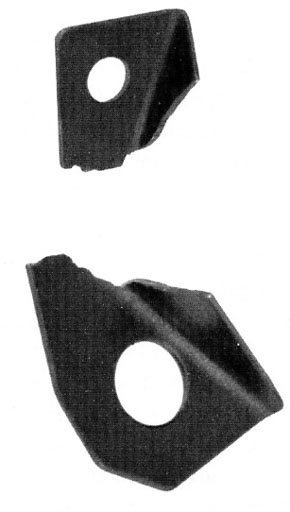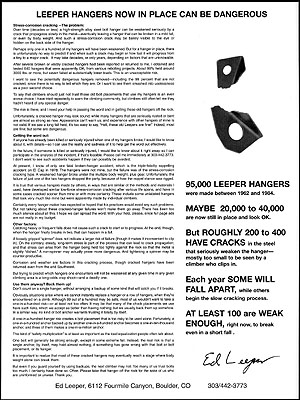LEEPER HANGERS NOW IN PLACE MAY BE DANGEROUS
Stress-corrosion cracking -The problem:
Over time (decades or less) a high-strength alloy
steel bolt hanger can be weakened seriously by a crack that propagates
slowly in the metal-eventually
leaving a hanger that can be broken in a mild fall, or even by body
weight. And such a stress-corrosion crack may be barely visible to
the eye or hidden on the back side of the hanger.
Perhaps only one in a hundred of my hangers will have been weakened. But for
a hanger in place, there is unfortunately no way to predict if and when such
a crack may begin or how fast it will progress from a tiny to a major crack.
It may take decades, or only years, depending on factors that are unknowable.
After several broken or visibly cracked hangers had been reported or
returned to me, I obtained and tested 640 hangers that were apparently
OK, from various rebolting projects. About 99% held around 3000 lbs.
or more, but seven failed at substantially lower loads. This is an
unacceptable risk. I want to see the potentially dangerous hangers
removed-including the 99 percent that are
not cracked, since there is no way to tell which they are. Or I want
to see them smashed into uselessness as a poor second choice.
To say that climbers should just not trust those old bolt placements that
use my hangers is an even worse choice. I have tried repeatedly to warn the
climbing community, but climbers still often tell me they hadn't heard of
any special danger.
The risk is there, and I need your help in passing the word and in
getting those old hangers off the rock. Unfortunately, a cracked hanger
may look sound; while many hangers that are seriously rusted or bent
are almost as strong as new. Appearance can't warn us, and experience
with other hangers of mine is not valid. If we see a long fall held,
it's too easy to say, "Hell,
these old Leepers are fine!" Indeed, most are fine; but some are
dangerous.
Getting the word out:
If anyone has already been killed or seriously
injured when one of my hangers broke, I would like to know about it,
with details-so I
can use the reality and sadness of it to help get the word out effectively.
In the future, if someone is killed or seriously injured, I would like to
know about it right away, so I can participate in the analysis of the incident,
if that's feasible. Please call me immediately at 303-442-3773. I don't want
to see such accidents happen if they can possibly be avoided.
At present, I know of only one fatal broken-hanger accident, which is the
triple-fatality rappelling accident on El Cap in 1978. The hangers were not
mine, but the failure was of the stress-corrosion cracking type. A weakened
hanger broke under the multiple body weight, plus gear. Unfortunately, the
failure of just one of the two hangers dropped the party, because of how the
rappel stance was rigged.
It is true that various hangers made by others, in ways that are similar to
the methods and materials I used, have developed similar low-force stress-corrosion
cracking after various life spans, and have in some cases cracked sooner than
mine or with more certainty. These include some unlabeled hangers that look
very much like mine but were apparently made by individual climbers. Certainly
every hanger maker has expected or hoped that his practices would avoid any
such problems.
But not talking about these cracked-hanger failures won't
make them go away. There has been too much silence about all this. I hope
we can spread the word. With your help, please, since full page ads are not
really in my budget.
Other factors:
Catching heavy or frequent falls does not cause such a crack to start or to
progress. At the end, though, when the hanger finally breaks in two, that
can happen in a fall.
A loosely gripped "spinner" does not indicate a larger risk of failure
(though it makes it inconvenient to clip in). On the contrary, steady, long-term
stress is part of the process that can lead to crack propagation; and that
stress can arise from the hanger being held too tightly against the rock so
that the metal is slightly "dished." A non-spinner may actually
prove more dangerous. And tightening a spinner may be counter-productive.
Corrosion and weather are factors in this cracking process, though cracked
hangers have been returned even from the arid Southwest.
But trying to predict which hangers one encounters will not be weakened
at any given time in any given climbing area is a long-odds crap shoot-and
a deadly one.
Use them anyway? Back them up!
Don't count on a single hanger, without arranging a backup of some kind that
will catch you if it breaks.
Obviously situations arise where we cannot instantly replace a hanger
or a row of hangers, when they're encountered on a climb. Although
99 out of a hundred may be safe, most of us wouldn't want to take a
one-in-a-hundred risk-or
at least not too often. It may be that many of the chock placements
we use have such risks, which we accept as better than having nothing;
but we usually back them up somehow. In a similar way, no kind of bolt
anchor warrants trusting it totally by itself.
A one-in-a-hundred hanger risk creates a bolt placement that is too risky
to be used alone. Fortunately, a one-in-a-hundred anchor backed up by another
one-in-a-hundred anchor becomes a one-in-ten-thousand anchor, and three of
them makes a one-in-a-million anchor.
This kind of "safety multiplication" is at least as important
as the load equalization people often talk about. One bolt will generally
be strong enough, except in some extreme fall. Instead, the real risk
is that a single anchor, by itself, may hold almost nothing, if something
has gone wrong with that bolt or bolt placement, or its hanger.
It is important to realize that most of these cracked hangers may eventually
reach a stage where body weight alone can break them.
But even if you guard yourself by using backups, the next climber may not.
Too many of us trust bolts too much. I certainly have done so. Often. Please
take that hanger off the rock for the sake of us who are uninformed or unwise.
Thank you.
Ed Leeper,
6112 Fourmile Canyon,
Boulder, CO
303/442-3773
Editor's Note 6.18.04:
After reading Ed's full-page
ads in Climbing and Rock & Ice, I realized that climbing webmasters
could help Ed get the word out. I called him to ask permission
to post the information; he answered right away and we had a great
conversation. Ed is 66, cheerful and sounds healthy. He's a bit
behind the times when it comes to the Internet, but is beginning
to realize it's potential.
Ed was very interested in the failure of the Leeper hanger on Desperado; his
first concern was for the climber (Dr. Waldeman) who enjoyed the thrilling
ride to the next bolt below. I assured Ed that no harm was done and that we
would try to get the remnants of the hanger to him.
You may be interested to know that Ed has extensive knowledge of physics
and electromagnetism. He has published a book about how proper wiring
and grounding can help suppress magnetic fields produced by power lines;
his website is silencingthefields.com
.





